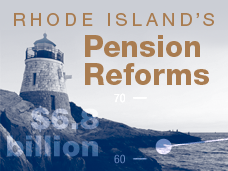The Widening Gap Update
States are $1.38 trillion short in funding retirement systems
QUICK SUMMARY
The gap between the promises states have made for public employees' retirement benefits and the money they have set aside to pay these bills was at least $1.38 trillion in fiscal year 2010, according to Pew's latest comprehensive analysis on pension and retiree health care funding.
States continue to lose ground in their efforts to cover the long-term costs of their employees' pensions and retiree health care. In fiscal year 2010, states were $1.38 trillion short of having saved enough to pay their retirement bills, a nine percent increase from the year before.
Over the last three years, the majority of states put reforms in place to better manage their retirement bills, but there is more work to be done to get back on solid fiscal footing.
REPORT CONTENTS
Key Findings
Pensions
Pension plans represent more than half of the retiree benefit funding shortfall. Experts say that a healthy pension system should be at least 80 percent funded.
- In 2010, only Wisconsin had fully funded its pension plan and 34 states were below the 80 percent threshold.
- Connecticut, Illinois, Kentucky, and Rhode Island were the worst among the states, with pensions funded under 55 percent in 2010.
- North Carolina, South Dakota, Washington, and Wisconsin were the best among the states, with pensions funded at 95 percent or better in 2010.
- Keeping up with the annual required contribution is perhaps the most effective way that states can responsibly manage their long-term liabilities for public sector retirement benefits. Pew's research shows that states that consistently make their full payments have better funded retirement systems and smaller gaps.
Retiree Health Care
States only have 5 percent of the funds needed to pay for their retirees' health care and other non-pension benefits—such as life insurance.
- 17 states did not set aside any money to fund their retiree health care liabilities.
- Only seven states had funded at least 25 percent of health care liabilities— Alaska, Arizona, North Dakota, Ohio, Oregon, Virginia, and Wisconsin.
- Alaska and Arizona are the best among states, with nearly 50 percent of their health care liabilities funded.
State Pension Reforms
States' public sector retirement funding gap for both pensions and retiree health benefits grew by $120 billion, from fiscal year 2009 to 2010. The largest part of that year-over-growth was the increase in pension liabilities. States are $757 billion short of funding their pension promises.
To meet these long-term pension obligations, nearly every state has moved to better manage its retirement bill in the last three years. Between 2009 and 2011, 43 states enacted benefit cuts, increased employee contributions, or both. The most common actions included:
- asking employees to contribute a larger amount toward their pension benefits
- increasing the age and years of service needed before retiring;
- limiting the annual cost of living increase; and
- changing the formula used to calculate benefits to provide a smaller pension check.
Rhode Island's Pensions Overhaul
The majority of reforms enacted in the last three years largely affect future state workers. However, some states are attempting more comprehensive reform in order to gain immediate cost savings.
In 2011, Rhode Island lawmakers approved an unprecedented overhaul of the state's traditional defined benefit pension plan. If the legislation survives a likely legal challenge, it will cut benefits for current as well as future employees and trim the state's unfunded liability by an estimated $3 billion. Learn more about Rhode Island's pension overhaul.
About Pew's Analysis
Pew's analysis of states' public sector retirement benefit funding, its fourth since 2007, uses states' own actuarial assumptions about how much money they expect the pension fund to earn, on average, on investments now and in the future. The numbers do not reflect the benefit cuts that many state legislatures enacted in 2010 and 2011 to shore up their pension funds in the future; the condition of some states may have improved because of those reforms.
Rhode Island, for example, reduced its unfunded liability by an estimated $3 billion through a series of benefit cuts enacted in 2011.
Pew assessed each state's management of its pension and retiree health care obligations as of fiscal year 2010 based on funding levels and contribution policies. States were rated as "solid performer," "needs improvement," or "serious concerns."
See the full methodology on page 9 of the PDF.




